In 1509, Henry VIII – one of England’s most famous monarchs – ascended the throne, ensuring the Tudor succession after his father, Henry VII, won the throne from Richard III at the Battle of Bosworth. After almost a decade of rule, the young King agreed to follow the advice of his close advisor, Cardinal Wolsey, and try and improve English relations with the Continent. After Wolsey’s efforts, in 1518 the Treaty of London was signed as a non-aggression pact between the major European powers of the time. The signatories were Burgundy, France, England, the Holy Roman Empire, the Netherlands, the Papal States and Spain, all of whom agreed not to attack one another and to come to the aid of any that were under attack. The idea came under the premise that Christian nations should not war with each other, particularly with the imminent threat of the Ottoman Empire.
One of the most important countries for England to make peace with was France, as the two countries had been at war intermittently for centuries over contested claims on who should rule territories in what is now modern-day France. Just a year after the Treaty of London was signed, tensions were already growing between the European powers, and so Wolsey decided to up diplomacy between England and France.
The French King, Francis I, was only 3 years younger than Henry, and both men had been hailed as great Renaissance princes. This meant the men certainly held great curiosity about each other. It was agreed that a great meeting would be held in Balinghem – at the time, this was considered an English territory, but as it was surrounded by French land, it was considered as close to neutral territory as could be found. It was also very close to the English port of Calais, making it an accessible location.

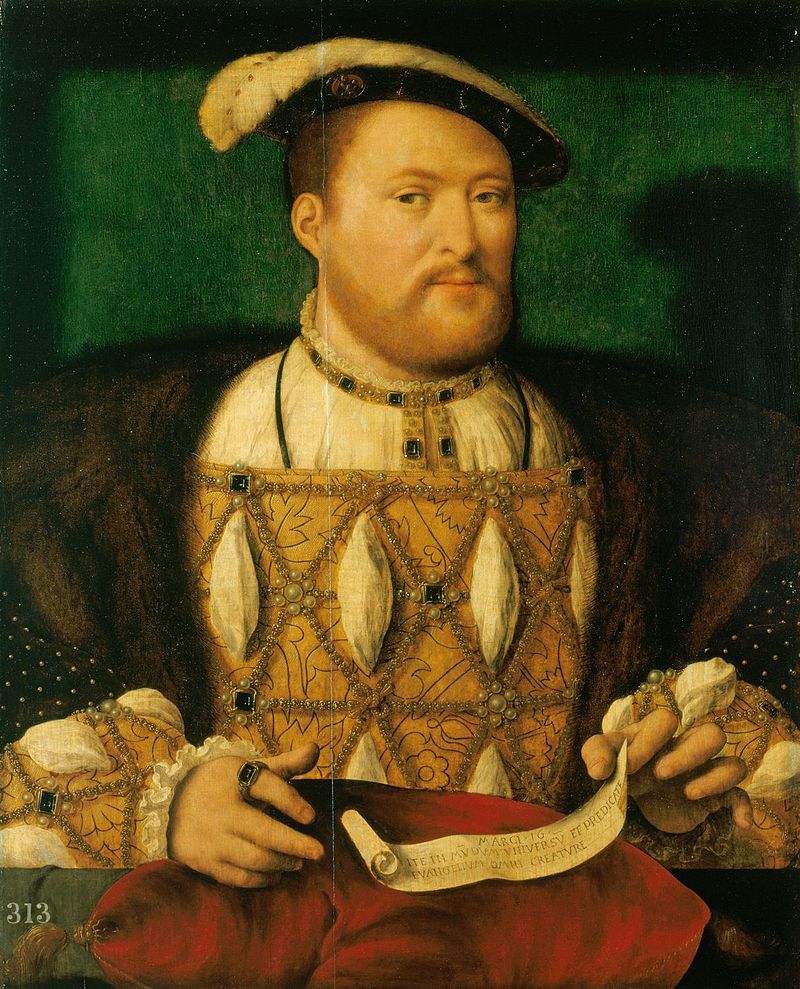
Francis I and Henry VIII
This wasn’t just going to be an everyday boring diplomatic meeting however. Both kings were young, wealthy, extravagant men who loved a good party. A date was set for June 1520, and what would follow is probably one of the greatest parties ever held.
Henry VIII and his Queen, Catherine of Aragon, left Dover for Calais on the 1st June, followed by their impressive retinue. They stayed at Calais for 6 days before continuing on to meet Francis. What met the party goers was a sight of such grandeur that it is impossible even now to imagine.
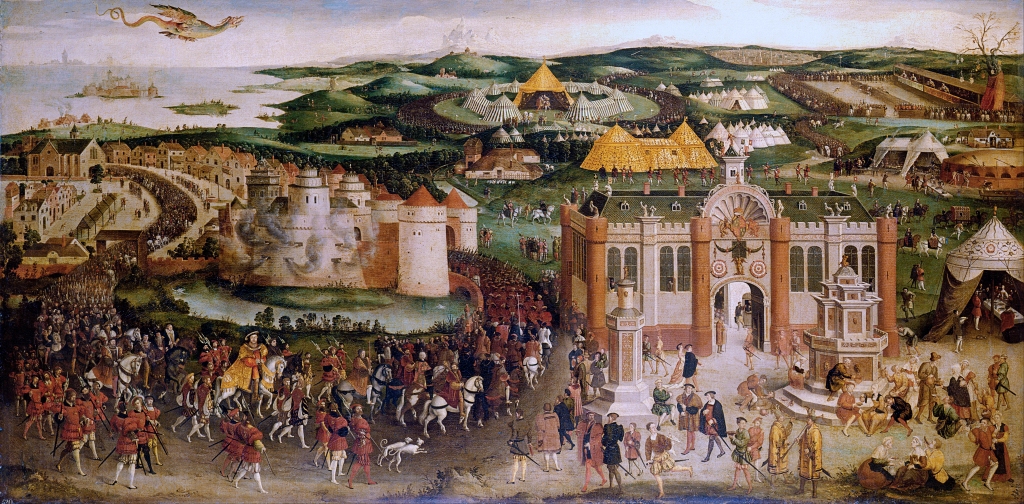
The Field of the Cloth of Gold, oil painting of circa 1545 in the Royal Collection at Hampton Court.
The meeting was an excuse for both Henry and Francis to show off the wealth of their kingdoms, and by proxy, their power – this was particularly important in Henry’s mind, as his display was not only for the eyes of the French king, but for the whole of Europe to show that England was a force to be reckoned with. Henry pitched up a marquee made out of gold cloth and had a great banquet. When the two kings met, the English and French retinues stood facing each other across the valley, and everyone was ordered to stand completely still in silence whilst Henry and Francis rode down between the retinues, embracing at the end as a sign of friendship. Then the festivities began.

From the British Library: These drawings are thought to be the original designs for the tents, which were connected by a series of galleries, following the arrangements of Tudor palaces. Spaces were divided by hangings of rich cloth, enabling the creation of reception rooms, private apartments, chapels and connecting galleries. Shelfmark: Cotton Ms. Augustus III. 18
Henry was renowned for his love of and skill in jousting, and so on Friday 9th June a jousting tournament began. Over the rest of the stay, various events in feats of arms were held, including running at the tilt, fighting tourneys on horseback and fighting on foot at the barriers with swords. It was agreed that the two kings wouldn’t meet each other on the jousting field, but Henry couldn’t resist challenging Francis to a wrestling match which, to his embarrassment, he quickly lost.
On Sunday 11th June, Henry went and dined with the French Queen, Claude of France, whilst Francis dined with Queen Catherine. Both feasts had hundreds of noblemen and women present, all dressed in cloths of gold, velvet and silks. Francis wore tissue-cloth set with precious stones and pearls. After the banquet ended, Francis went from one end of the room to the other, carrying his hat in his hand and kissing all the ladies on both sides – except for four or five who were too old and ugly (what a pleasant man).
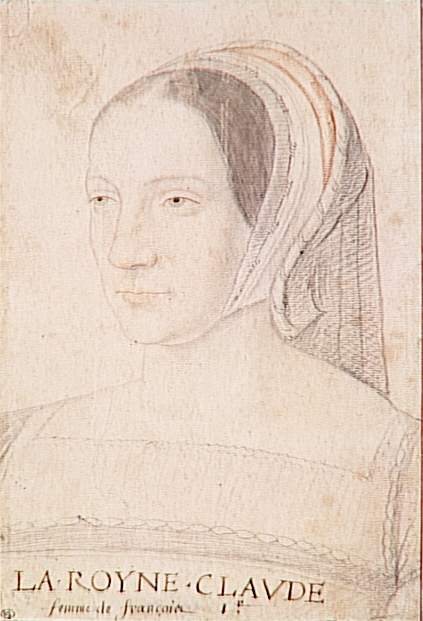
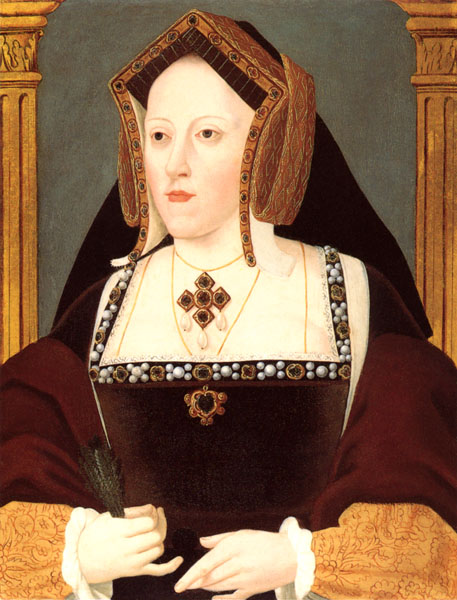
Queen Claude of France and Queen Catherine of Aragon
The next day the Kings met with their Queens in tow. Queen Claude was accompanied by her ladies-in-waiting, all riding in litters and sedan chairs covered in sumptuous embroidery, and more ladies who also were seated on luxurious palfreys joined. Then a day of jousting followed, with both Kings taking part.
On Saturday 17th June, both kings met in the field, and Henry’s outfit was unbelievable: his armour-skirt and horse-trapper were decorated with 2,000 ounces of gold and 1,100 huge pearls. The cost of it was said by one chronicler to be “innumerable to my demyng to bee summed” and he wasn’t exaggerating – the cost must have been extortionate. The Earl of Devonshire also wore cloth of gold, tissue-cloth and cloth of silver, all elaborately embroidered, with his retinue wearing the same uniform. This was meant to impress and it certainly would have.

Henry stands out in his gold outfit even on a painting this large.
On Saturday 23rd June a large timber chapel was built, decorated with richly embroidered cloths, and filled with holy relics and statues. Henry bore the full cost of erecting this costly chapel. The Lord Cardinal said mass in the chapel before both royal couples, and afterwards the kings and their retinues had a huge feast. The following day the celebrations ended with both kings parting on seemingly amicable terms; Henry gave Francis a collar of jewels decorated with diamonds and pearls, whilst Francis gave Henry a bracelet of precious stones decorated with rich jewels.
Whilst the celebrations were a success, in reality it did little to approve relations between England and France, and within a few years the countries were once again at war.
One of the most impressive structures of the Field of the Cloth of Gold was certainly the huge temporary palace that Henry had erected; it covered an area of nearly 12,000 square yards (10,000 m2). The palace was set out as a quadrant, with each side 100m long and about 12m high. It had a 2m high brick base, with 10m of cloth or canvas on timber frames, painted to look like stone or brick on top of the brick base. When one entered the palace they found a fountain gilded with gold, ontop of which was a statue of “the olde God of wyne called Bacchus birlyng the wyne, whiche by the conduyetes in therth ranne to all people plenteously with red, white, and claret wyne”. That’s right, a fountain of wine which anyone could drink from. Henry knew how to throw a party.

The temporary palace and the fountain of wine (to the right) can be seen on the Field of the Cloth of Gold painting.
The event was so named because at every turn there were tents and costumes that displayed so much cloth of gold, an expensive fabric woven with silk and gold thread. The amount of people there was huge – Henry’s followers alone ate 2200 sheep and similar amounts of other meats in one month. In the fields beyond the castle, 2800 tents were erected for less distinguished visitors. From papers of Henry VIII’s, we know that in the planning, Henry had planned for 3,997 persons and 2,087 horses for his own retinue, whilst Catherine had 1,175 persons and 778 horses. That’s over 5,000 people just on the English side alone!
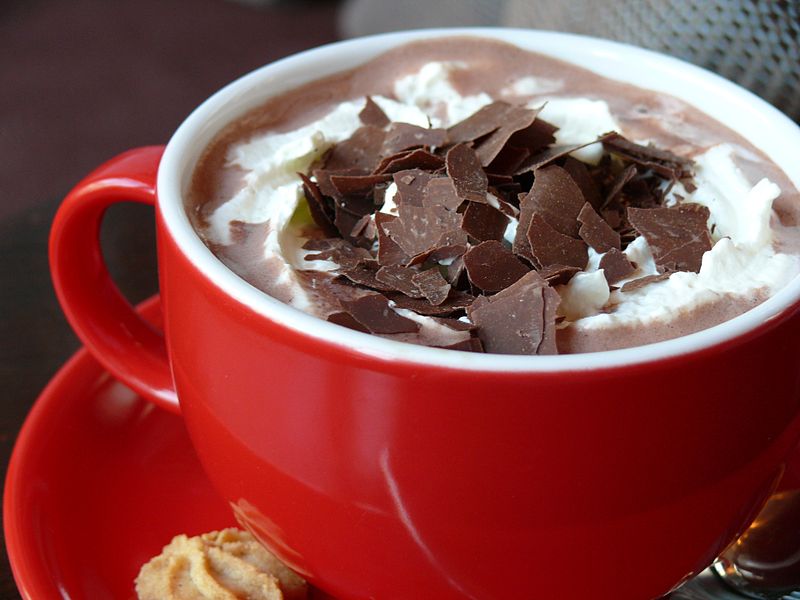
Enjoying this blog post? Buy me a hot chocolate!
Consider donating the cost of a hot chocolate to me, so I can continue to write and run Just History Posts.
£3.50
According to a guesstimate by historian Greg Jenner:
“King Francis I spent 400,000 livres (£40,000 in Tudor money) on this 2-week spectacle. But the crown later sold off lots of the fabric and accoutrements in 1543, recouping 125,000 livres. So, let’s be generous and say he only spent £27,000 / 275,000 livres. The annual royal expenditure in running the court, in 1523, was 543,800 livres. But, in terms of the wider French economy, the field of Cloth of Gold cost about 1/8 of the state’s annual budget.
King Henry VIII, never one for modesty, spent £36,000 on the festivities – more than his royal household’s entire annual expenditure, and more than 1/3 of England’s total annual income of £90,000…
In summary, the Field of Cloth of Gold – with all its trappings (including wine fountain and gold-encrusted monkeys, obviously) – cost £63,000 in Tudor money.”
Wow! Jenner goes on to try and roughly equate that to modern money, where he comes to the figure of around £32.3m by today’s standards, but he points out that even this alone cannot emphasise enough the extravagance of the two week event – if economies etc were to be properly compared, the Field of the Cloth of Gold would probably cost hundreds of billions today.
So all in all, the Field of the Cloth of Gold can probably be argued as one of the biggest parties ever held. Even now I struggle to imagine how incredible it must have been, and to have been lucky enough to be an attendant must have been an unforgettable experience. The beauty, the lavishness, the sumptuous fabrics and huge amounts of food, the booze, the fighting, the dancing – it must have been, in the original sense of the word, quite awesome.
Previous Blog Post: Mythical Creatures: Medieval Mermaids
Previous in Important Events: The Medieval Titanic: The tragedy of the White Ship Disaster
List of Blog Posts: here Blog Homepage: here
Buy my books via the pictures below! Or why not check out our shop?
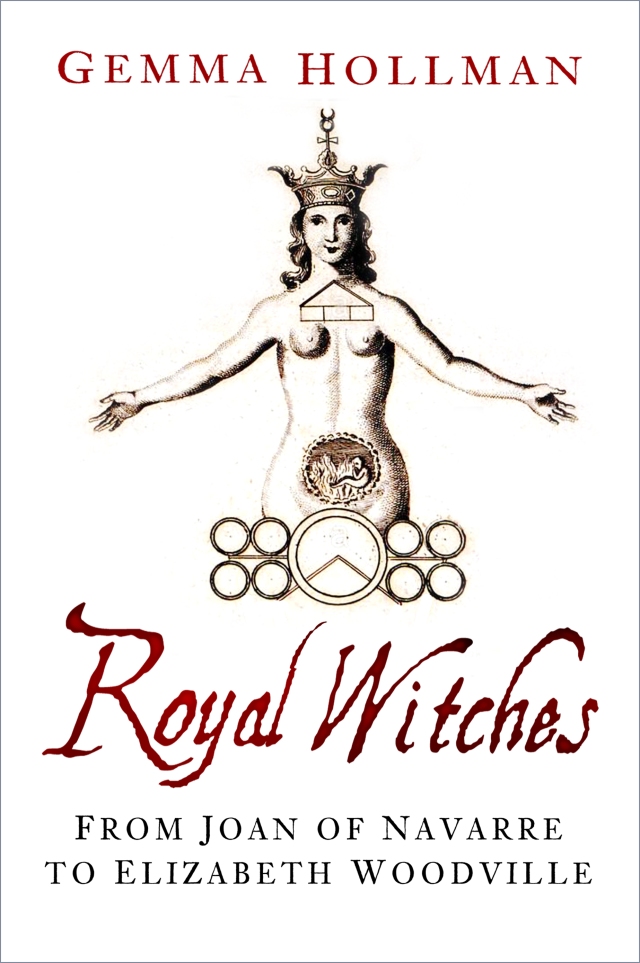
Follow us:


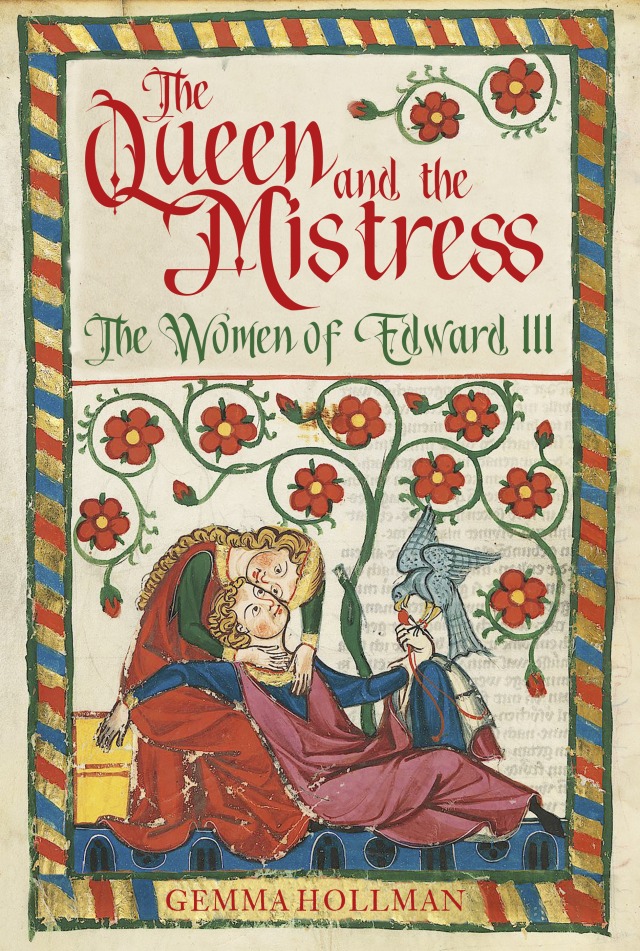



I NEED A WINE FOUNTAIN PLEASE.
LikeLike
Right?! Might get on to my plumber about getting one installed…
LikeLike
I recall a holiday in Germany when we traveled down the Rhine to the confluence with the Moselle, then a short distance up that river to a village where a typical German wine festival was underway. The fountain in the town square had been charged up with young wine and you could hep yourself using little glasses about the size of a shot glass. This was back in the 1980s. Don’t know if they still do it but maybe a holiday in Germany could make your wish come true!
LikeLiked by 2 people
Wow that sounds great! Shall definitely need to put it on the travel list and have a look!
LikeLiked by 1 person
Ahhh haha I’ll have to look into it! Dreams can come true!
LikeLiked by 1 person
Awesome indeed.
LikeLiked by 1 person
I believe Thomas a Becket before he became arch bishop, when he was Henry II’s chancellor, organised a similar party for the King of France. Thanks for liking my reblogged post from Christoph Fischer about David Lawlor’s new book.
LikeLike
Oh interesting, I don’t think I’ve heard of that, I will have to look it up!
LikeLike